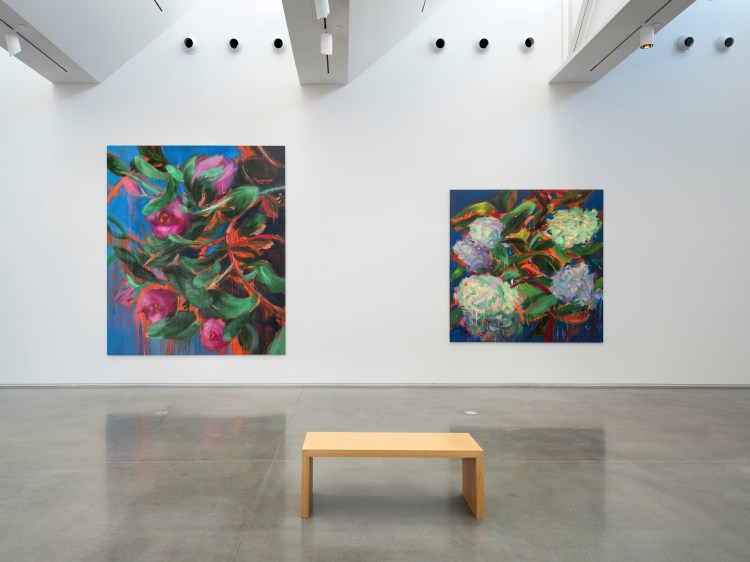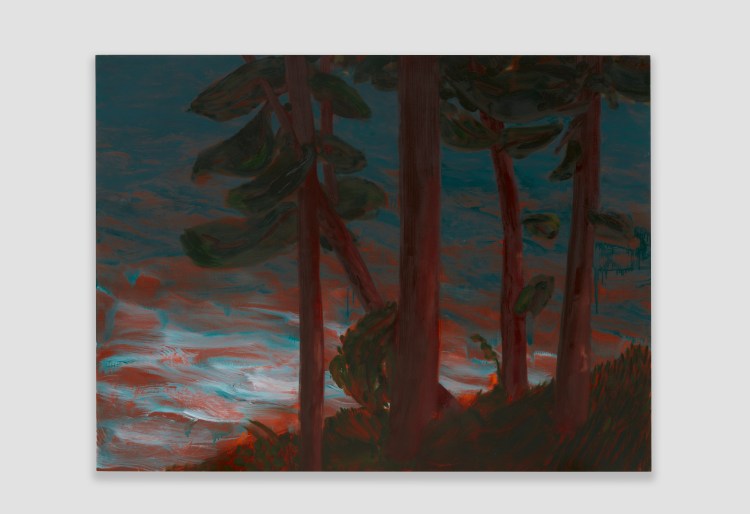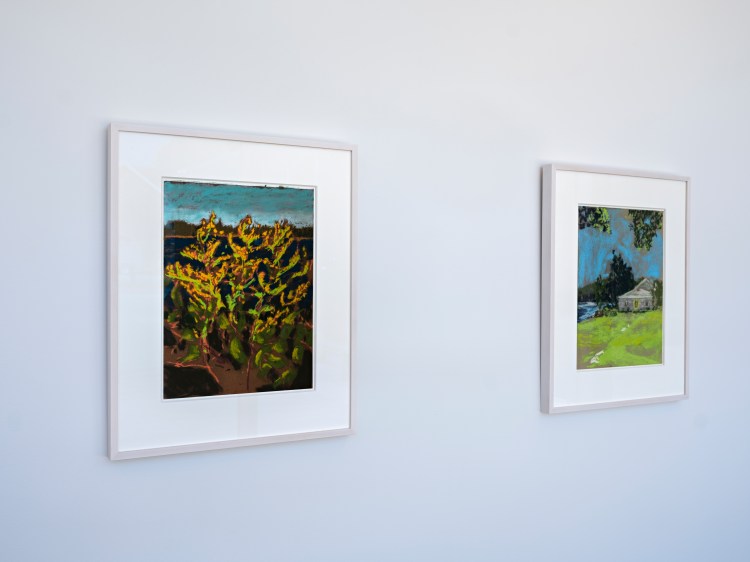
CAMDEN — Heaven, I’m in heaven
And my heart beats so that I can hardly speak
And I seem to find the happiness I seek
When we’re out together dancing cheek to cheek
So begins the song “Cheek to Cheek,” written by Irving Berlin for the 1935 movie “Top Hat” starring Fred Astaire and Ginger Rogers. “Cheek to Cheek” is also the name of a solo show through September 14 at the Center for Maine Contemporary Art in Rockland for the artist Nicole Wittenberg.
Further south, the Ogunquit Museum of American Art is also hosting a solo exhibition of Wittenberg’s work through July 20, this one borrowing its name from the Billie Holiday’s rendition of “A Sailboat in the Moonlight.”
These dual shows in Maine also coincide with an exhibition in Paris (titled “Ain’t Misbehavin'” after the Fats Waller song) and a detailed monograph published by Monacelli Press.
Wittenberg is based in New York, but the three concurrent shows reflect the increasing amount of time she has spent in Maine in recent years. Taped to one wall of the artist’s studio in Camden are snapshots of pink beach roses, the kind that will soon bloom along the state’s sandy paths.
But these images aren’t a reference to a flower or even a song so much as they are to a feeling.
“I’m interested in remembering the moment I took the photograph, not the photograph itself,” Wittenberg, 46, said. “There’s something about making images so large, because actually the feeling of sitting on the seashore looking at these wild roses is a very big feeling. I feel fully alive there.”

‘A luxurious place’
Wittenberg grew up on the sea, but on the opposite coast. She first visited the state in 2012 for a show at Colby College in Waterville, and the landscape reminded her of the untouched nature of her native northern California.
“It’s interesting to live in an environment like New York City that’s so dense and to spend so many years there,” Wittenberg said. “Nothing felt more luxurious than to leave that density and to shed that density and to be in a place that gives you the luxury of having time and space to make things. Maine is a very luxurious place.”
Wittenberg started spending more and more time in Maine, and Maine started showing up more and more in her work. She spends much of the summer in Midcoast now, and she passes hours outside making pastel sketches of nature that later inform her larger paintings (Both museums in Maine are showing examples of these rich, rough sketches).

In her early 20s, Wittenberg moved to Venice to work in glass sculpture. Her year exploring the artwork in that historic city made a lasting impression on her.
“The scale of the paintings, the subject matter and the content of those paintings was a direct reflection of the church that it was housed within,” Wittenberg said. “Oftentimes, the architect and the painter were working together, or the paintings were made in response directly to the architecture.”

In Maine, she made work specific to each show and setting. When Wittenberg started planning her exhibition at the CMCA, she knew she wanted to exhibit in the main gallery with its 20-foot-high ceilings (She also jumped at the chance to make work in the museum designed by Toshiko Mori; she has known the architect for years). The paintings she made for that space are as tall as 11 feet, so large that she at times used brooms as brushes.
“She really wanted the challenge of showing in that main gallery space, the opportunity to scale up and make paintings that could hold that whole environment,” said Suzette McAvoy, the museum’s former executive director who worked with Wittenberg on this show.
The bigger the canvas got, the more the artist zoomed in on her subjects. These five canvases are full of flowers so close and consuming that it is as if the viewer has bent down to smell them.
“When you go up close to those huge flower paintings, you get enveloped in them,” McAvoy said. “The paintings push out at the viewer instead of pulling you in.”
In Ogunquit, her paintings flank a massive window and offer their own view into nature. There is a stand of trees on the canvas, and a stand of trees outside the glass.
“It enters the dialogue between the exterior,” said Devon Zimmerman, curator of modern and contemporary art. “How do we open up the museum into this dialogue between the grounds and the landscape without and the artwork within?”

Feeling alive
Wittenberg is known in part for her erotic paintings inspired by amateur pornography. The paintings that she is currently showing are inspired by nature, all woods and wildflowers. But Wittenberg doesn’t distinguish between these bodies of work.
“The subject matter changes, but the content for me stays the same,” she said.
The curators of the two shows also see a continuity between her earlier paintings and these more recent ones.

At the Center for Maine Contemporary Art, Wittenberg is showing massive paintings of beach roses and hydrangeas.
“There is an intimacy to these works,” McAvoy said. “It is this almost erotic sensation of these flowers conjoining and swirling. There’s a fecundacy. It’s very sensuous. There’s a wonderful quality that I think does thread through her work.”
At the Ogunquit Museum, the exhibit is more of a survey of landscapes from woodland paths to moonlit water.
“The trees sway and move,” Zimmerman said. “The water undulates. Everything feels just as alive.”
Both McAvoy and Zimmerman see Wittenberg as part of a legacy of painters coming to Maine and responding to the landscape in new ways. Zimmerman stood in front of “Upheaval 2,” a lush scene of woods and water rendered with orange and pink and teal.
“I know the temperature of that ocean,” Zimmerman said. “I feel something about it in a bodily way.”

‘A soft breeze on a June night’
The curators described Wittenberg as disciplined, spending long hours in the studio, and the artist said she often listens to music while she paints. (Lana Del Ray was the soundtrack for much of her work on these paintings.) The titles of her exhibitions are often references to songs.
This summer, her three shows all take their names from tunes from the 1930s. There’s plenty of little connections with the individual titles — Irving Berlin grew up very near Wittenberg’s studio in New York, for example — but these paintings also just have the same energy as jazz. Take Billie Holiday’s rendition of “A Sailboat in the Moonlight.” The title seemed just right for the show in Ogunquit, where a visitor might literally see a sailboat just outside the window. But the painter also felt a connection to the singer.
“She’s an incredible singer and performer who moves through the lyrics with a great amount of feeling,” Wittenberg. “She punctuates the music with her voice. She doesn’t stick to the music, she has her own delivery of her voice within the framework of the musical score. There’s a working within and outside the structure of the music, which is something I’m also very interested in with these paintings, because they’re very gestural.”

Wittenberg, too, is working with a great amount of feeling. She is thinking, for example, about the way she felt when she was making pastel sketches of roses in the wild on a summer evening.
“I really like the raking light, when it’s going sideways and raking through the petals, which become very illuminated and transparent,” she said. “I wanted to see if I could talk to the feeling of the wildflowers growing and the sensation of the light at around 5 p.m. in July or August when there’s a kind of stillness and a kind of vibrancy that are happening at once.”
In both shows, Wittenberg chose hot pinks and oranges and reds for the backgrounds of her paintings. The effect is striking in a visual sense — the greens of the leaves are that much brighter for the contrast — and in an emotional sense — the feeling is the warmth of the summer sun on your skin.
“It lends to the sense that there is a moment, a memory that you’re capturing,” Zimmerman said. “That it’s here as quickly as Nicole felt it, and it’s gone. So there’s this constant sense of grasping at something that was felt and lived and remembered.”
It’s just as Holiday sang it:
A sailboat in the moonlight and you
Wouldn’t that be heaven, a heaven just for two
A soft breeze on a June night and you
What a perfect setting for letting dreams come true

IF YOU GO
“A Sailboat in the Moonlight”
Ogunquit Museum of American Art
Through July 20
ogunquitmuseum.org or 207-646-4909
“Cheek to Cheek”
Center for Maine Contemporary Art, Rockland
Through Sept. 14
cmcanow.org or 207-701-5005

